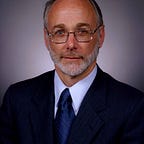Shining a light on technology and infrastructure to reach the “Moon”
Thank you Mr. Vice President!
Over the last several decades, the “war on cancer” has been characterized as a series of lengthy, hard-fought and costly campaigns resulting in a limited number of significant but narrow victories against a complex and ever-mutable foe.
Despite advances, early detection of the most lethal cancers including brain, lung, ovarian and pancreatic remains elusive because current treatment protocols are ineffective for many cancer patients.
Enough is enough.
Your National Cancer Moonshot Task Force is a welcomed call to arms. It sends a powerful message to patients, survivors, their families, health care providers and the American public that we cannot afford to wait to cure cancer any longer; we MUST double the rate of cancer progress to make a decades’ worth of advances in five years.
To achieve the National Cancer Moonshot goal will require academia, industry and federal government engagement across the full spectrum of cancer management, and the National Photonics Initiative (NPI) — a collaborative alliance among industry, academia and government seeking to raise awareness of optics and photonics, the science and application of light — is poised to effectively facilitate that activity.
As chair of the NPI Cancer Moonshot Task Force, I am pleased to announce that we recently launched a new multi-disciplinary effort that will identify technology advancements critical to the National Cancer Moonshot and provide a blueprint for effective public and private investments. The NPI has brought together thought leaders and health care providers from leading academic institutions, patient organizations, hospitals and the medical device industry including the Lung Cancer Alliance, Prevent Cancer Foundation, Siemens, the Advanced Medical Technology Association (AdvaMed), the Medical Imaging and Technology Alliance (MITA), The Optical Society (OSA), the International Society for Optics and Photonics (SPIE), MD Anderson Cancer Center, Stanford University, Rush University Medical Center, University of Texas Health Science Center, University of Chicago and Rice University. This collaboration will leverage their annual investment in research in cancer diagnosis and therapeutics technologies — which exceeds $3 billion — to maximize both existing and new early detection and treatment technologies while also exploring cost-effective approaches amenable to community-based practices.
The good news is that our country can make significant strides within the next five years by effectively utilizing existing technologies — combining quantitative imaging diagnostic solutions with biomolecular analysis and computational strategies for machine learning. Focused investments will stimulate development of new low-cost, precise, early detection technologies and treatment protocols. Public-private partnerships and coordinated investments will drive innovation in areas such as imaging instrumentation, companion biomolecular and image-based predictive assays, and bioinformatics infrastructure that will improve patient outcomes in each stage of cancer diagnosis and treatment, while significantly reducing medical costs. Our recommendations — advances in optics and photonics technologies, molecular probes, new companion biomolecular assays and a national IT infrastructure — are essential for ushering in these next generation tools that will benefit patients across the spectrum of cancer management.
The NPI and its collaborating partners welcome the opportunity to work with you, Mr. Vice President, to shine a light on the technologies and infrastructure that will advance early detection and treatment of the most difficult cancers and ultimately save many lives.
